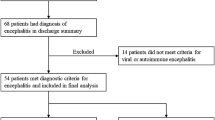Abstract
This study evaluates clinical findings, magnetic resonance imaging (MRI), and response to antiepileptic drugs (AEDs) in encephalitis patients with status epilepticus (SE). Encephalitis patients with SE were included and they were grouped into herpes (HSE), Japanese (JE), dengue, and nonspecific encephalitis on the basis of virological studies. The demographic and clinical details, including SE type and duration, were noted. Cranial MRI and cerebrospinal fluid (CSF) were carried out. Response to first, second, and third AEDs were noted and the patients not responding to the second AED were considered refractory SE. The relationships of the mortality and the refractoriness of SE with various clinical findings, MRI, CSF, and the type of encephalitis were evaluated. Thirty SE patients with encephalitis aged 1 to 64 years were included. Nine patients had JE, 4 HSE, 1 dengue, and 16 nonspecific encephalitis. Generalized convulsive SE was present in 26 and nonconvulsive SE in 4 patients. The mean duration of SE was 21 (0.83 to 72) h. MRI was abnormal in 20 patients. A 46.7% of patients responded to the first AED and 36.7% remained refractory to the second AED. In 26.7% patients, the seizure continued even after the third AED. The response to AED was not related to the clinical, MRI, and laboratory variables. Nine patients died and the mortality was related to gender and Glasgow Coma Scale (GCS) score. In encephalitis with SE, 46.7% patients responded to the fist AED and 36.7% remained refractory to the second AED. One third of patients died, which was related to the depth of coma.
Similar content being viewed by others
References
Advisory Committee in Immunization Practices (1993). Inactivated Japanese encephalitis virus vaccine. Recommendations of the advisory Committee on Immunization Practices (ACIP). MMWR Morb Mortal Wkly Rep 42(RR-1): 1–15.
Campistol J, Fernandez A, Ortega J (1999). Status epilepticus in children experience with intravenous valproate: update of treatment guidelines. Rev Neurol 29: 359–365.
Erol I, Alehan F, Yalcin K (2006). Refractory status epilepticus owing to human parvovirus B19 encephalitis in a child. J Child Neurol 21: 820–822.
Falconer MA, Serafetinides EA, Corsellis JA (1964). Biology and pathogenesis of temporal lobe epilepsy. Arch Neurol 10: 233–248.
Giroud M, Gras D, Escousse A, Dumas R, Venaud G (1993). Use of injectable valproic acid in status epilepticus. Drug Investig 5: 154–159.
Gunduz A, Beskardes AF, Kutlu A, Ozkara C, Karaagae N, Yeni SN (2006). Herpes simplex encephalitis as a cause of nonconvulsive status epilepticus. Epileptic Disorder 8: 57–60.
Holtkamp M, Othman J, Buchheim K, Melerkord H (2005). Predictors and prognosis of refractory status epilepticus treated in a neurological intensive care unit. J Neurol Neurolsurg Psychiat 76: 534–539.
Kalita J, Misra UK (2000). Comparison of CT scan and MRI findings in the diagnosis of Japanese encephalitis. J Neurol Sci 174: 3–8.
Kalita J, Misra UK, Pandey S, Dhole TN (2003). A comparison of clinical and radiological findings in adults and children with Japanese encephalitis. Arch Neurol 60: 1760–1764.
Kalita J, Misra UK, Patel R (2006). Initial EEG in status epilepticus is helpful in predicting seizure recurrence. Electromyogr Clin Neurophysiol 46: 139–144.
Knake S, Rosenow F, Vescovi M, Oertel WH, Mueller HH, Wirbatz A, Katsarou N, Hamer HM (2001). Status Epilepticus Study Group Hessen (SESGH). Incidence of status epilepticus in adults in Germany: a prospective, population-based study. Epilepsia 42: 714–718.
Mayer SA, Claassen J, Lokin J, Mendelsohn F, Dennis LJ, Fitzsimmons BF (2002). Refractory status epilepticus: frequency, risk factors, and impact on outcome. Arch Neurol 59: 205–210.
McGrath N, Anderson ND, Crixson MC, Powell KF (1997). Herpes simplex encephalitis treated with acyclovir: diagnosis and longterm outcome. J Neruol Neurosurg Psychiatry 63: 321–326.
Misra UK, Kalita J (2001). Seizures in Japanese encephalitis. J Neurol Sci 190: 57–60.
Misra UK, Kalita J, Patel R (2006). Sodium valproate vs phenytoin in status epilepticus: a pilot study. Neurology 67: 340–342.
Misra UK, Kalita J, Srivastava M (1998). Prognosis of Japanese encephalitis: a multivariate analysis. J Neurol Sci 161: 143–147.
Parent JM, Lowenstein DH (1994). Treatment of refractory generalized status epilepticus with continuous infusion of midazolam. Neurology 44: 1837–1840.
Prasad A, Worrall BB, Bertram EH, Bleck TP (2001). Propofol and midazolam in the treatment of refractory status epilepticus. Epilepsia 42: 380–386.
Raschilas F, Wolff M, Delatour F, Chaffaut C, De Broucker T, Chevret S, Lebon P, Canton P, Rozenberg F (2002). Outcome of and prognostic factors for herpes simplex encephalitis in adult patients: results of a multicenter study. Clin Infect Dis 35: 254–260.
Shankar SK, Vasudev RT, Mruthyunjayanna BP, Gourie Devi M, Deshpande DH (1983). Autopsy study of brains during an epidemic of Japanese encephalitis in Karnataka. Indian J Med Res 78: 431–440.
Solomon T, Dung MN, Kneen R, Thao LTT, Gainsborough M, Nisalak A, Day NPT, Kirkham FJ, Voughn DW, Smith S, White NJ (2002). Seizure and raised intracranial pressure in Vietnamese patients with Japanese encephalitis. Brain 125: 1084–1093.
Treiman DM, Meyers PD, Walton NY, Collins JF, Colling C, Rowan AJ, Handforth A, Faught E, Calabrese VP, Uthman BM, Ramsay RE, Mamdani MB (1998). A comparison of four treatments for generalized convulsive status epilepticus. Veterans Affairs Status Epilepticus Cooperative Study Group. N Engl J Med 339: 792–798.
Valdlamudi L, Scehfter ID, Berkovic SF (2003). Genetics of temporal lobe epilepsy. J Neurol Neurosurg Psychiat 74: 1359–1361.
Vignatelli L, Tonon C, D’Alessandro R (2003). Bologna Group for the Study of Status Epilepticus. Incidence and short-term prognosis of status epilepticus in adults in Bologna, Italy. Epilepsia 44: 964–968.
Yafte K, Lowenstein DH (1993). Prognostic factors of phenobarbital therapy for refracting gene molecule status epilepticus. Neurology 43: 895–900.
Zimmerman HM (1946). Pathology of Japanese encephalitis. Am J Pathol 22: 965–991.
Author information
Authors and Affiliations
Corresponding author
Rights and permissions
About this article
Cite this article
Kalita, J., Nair, P.P. & Misra, U.K. Status epilepticus in encephalitis: a study of clinical findings, magnetic resonance imaging, and response to antiepileptic drugs. Journal of NeuroVirology 14, 412–417 (2008). https://doi.org/10.1080/13550280802266523
Received:
Revised:
Accepted:
Issue Date:
DOI: https://doi.org/10.1080/13550280802266523




